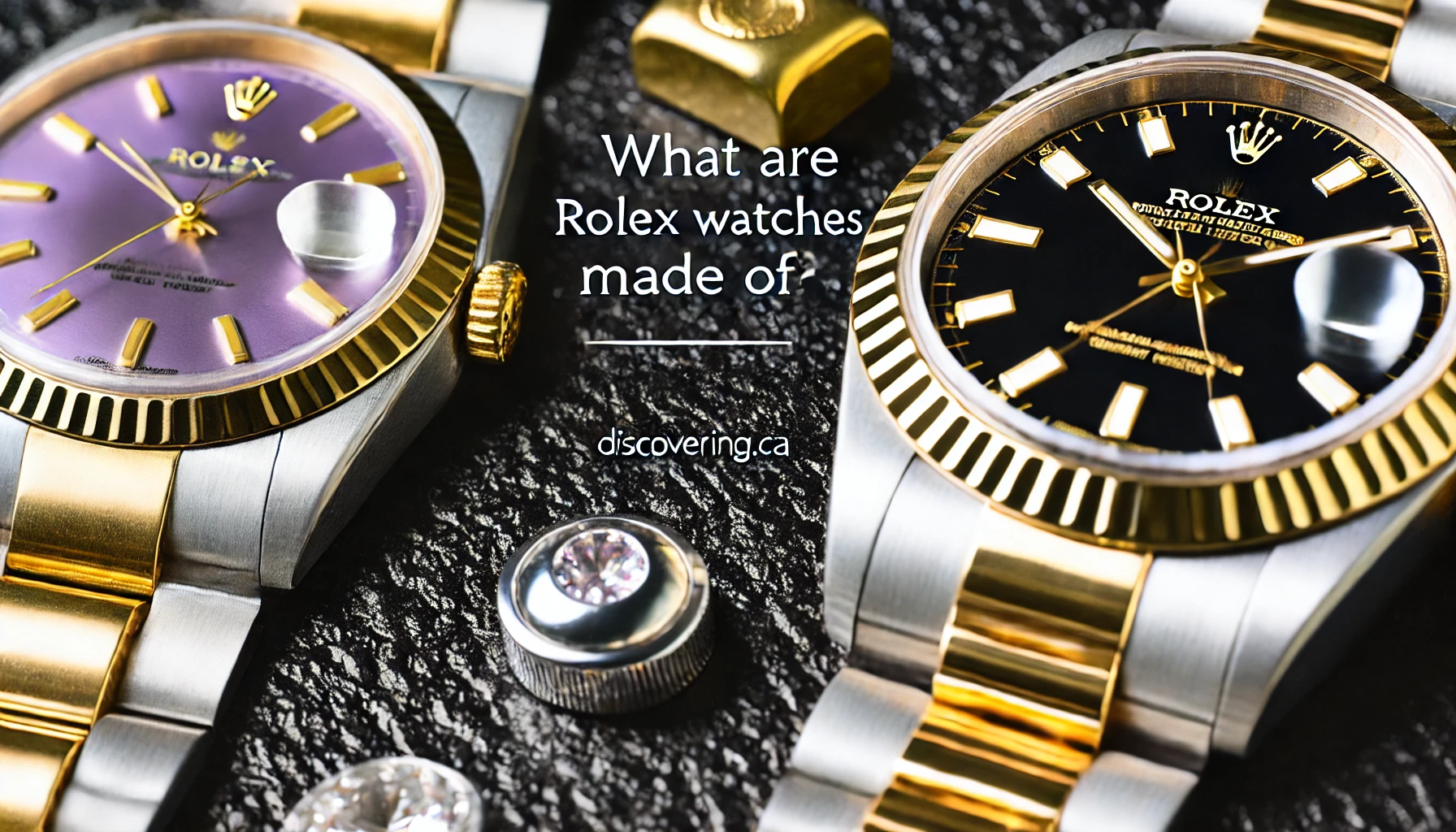What Are Rolex Watches Made Of? Discoveringly’s Guide to the Materials Behind the Icon
Rolex watches are icons of luxury and precision, known worldwide for their craftsmanship, innovation, and high-quality materials. Rolex uses a unique combination of metals, alloys, and gems that make their timepieces both stunningly beautiful and incredibly durable. If you’ve ever wondered what gives a Rolex its timeless appeal, let’s explore the exquisite materials and attention to detail that go into every Rolex watch.
1. The Materials That Make a Rolex
Rolex doesn’t settle for ordinary materials; they meticulously select, refine, and manufacture their own metals to ensure the highest standard of quality. Here’s an inside look at the materials Rolex uses:
- Oystersteel: A proprietary version of 904L stainless steel, Oystersteel is highly resistant to corrosion and keeps its polish, giving Rolex watches a superior, long-lasting shine. It’s specifically chosen for its toughness, especially for models like the Submariner and Explorer that need to withstand extreme environments.
- Gold: Rolex uses only 18-karat gold for its gold models, available in three unique colors: yellow, white, and Everose. They even have their own foundry to ensure a consistent quality of gold alloy.
- Platinum: Known for its rarity and weight, platinum is used in select models like the Rolex Day-Date. Rolex combines platinum with a hint of ruthenium, giving it a slightly bluish sheen that enhances its elegance.
- Cerachrom Bezel: Many Rolex models feature a scratch-resistant Cerachrom bezel, crafted from a special ceramic that’s virtually immune to scratches and fading, perfect for preserving the look of sports models like the GMT-Master II.
2. The Role of Precious Gems
Rolex uses only the highest quality gems, including diamonds, rubies, and sapphires, which are carefully hand-selected and set by master jewelers. Each stone must pass stringent quality tests to ensure brilliance and consistency.
- Diamonds: Rolex diamonds are of the highest grade, usually D-G color and IF-VVS clarity. They are carefully set in patterns on dials, bezels, and hour markers for specific models, adding a touch of timeless glamour.
- Gem-Setting Expertise: Rolex has a dedicated team of gemologists and jewelers who oversee the selection, inspection, and setting of each gemstone. Each piece is positioned with precision to capture light in the most captivating way.
3. Rolex Movements: The Heart of the Watch
A Rolex’s precision comes from its in-house movements, each crafted and assembled by expert watchmakers. These movements are meticulously tested to meet Rolex’s standards of excellence. Known for their reliability and durability, Rolex movements include features like:
- Perpetual Rotor: This self-winding mechanism powers Rolex automatic watches. When worn, the rotor harnesses natural wrist movement to keep the watch ticking without needing manual winding.
- Parachrom Hairspring: This hairspring is made from a niobium and zirconium alloy, giving it resilience against shocks and temperature variations, ensuring the watch remains accurate in all conditions.
- Superlative Chronometer Certification: After assembly, each Rolex movement undergoes extensive testing and is certified as a “Superlative Chronometer” by Rolex, guaranteeing its accuracy to within -2/+2 seconds per day, exceeding the industry standard.
4. Exclusive Manufacturing Process
Rolex doesn’t just use premium materials—they make many of these components in-house. The brand has a foundry where they create their own alloys, including the 18-karat gold and Everose gold. This control over the entire production process, from raw materials to final assembly, is one reason Rolex watches have unmatched quality and consistency.
5. Innovative and Resilient Designs
Every material in a Rolex watch is chosen to enhance durability and withstand the elements. From deep-sea dives to mountain peaks, Rolex watches are designed to endure:
- Scratch-Resistant Sapphire Crystal: The watch face is protected by a sapphire crystal, a synthetic gem that’s highly scratch-resistant, maintaining the watch’s clarity and brilliance over time.
- Twinlock and Triplock Crowns: These crowns feature double or triple seals for superior water resistance, ensuring a Rolex can perform under extreme water pressure. Models like the Sea-Dweller can even withstand depths of up to 4,000 meters.
- Luminescent Markers: Many Rolex watches use Chromalight for hour markers and hands, a material that emits a long-lasting blue glow in low-light conditions, enhancing legibility and style.
6. A Heritage of Quality and Excellence
Rolex’s attention to material quality isn’t just about luxury—it’s about creating a watch that endures. The brand has a strict commitment to excellence, rigorously testing each watch under real-life conditions to ensure it performs flawlessly, year after year.
7. Frequently Asked Questions
Q: Why does Rolex make its own metals?
A: Rolex is committed to the highest standards, and by controlling the entire process, they ensure every piece of metal meets their specific durability, color, and quality criteria.
Q: What makes Oystersteel unique?
A: Oystersteel is Rolex’s proprietary stainless steel that’s highly resistant to corrosion, ensuring that each watch retains its shine and finish, even after years of wear.
Q: Are all Rolex watches waterproof?
A: Yes, all Rolex Oyster models are waterproof to at least 100 meters. Certain models, like the Rolex Submariner and Sea-Dweller, are designed for even greater depths.
Rolex watches are crafted with unmatched precision and care, using some of the world’s finest materials. From Oystersteel and 18K gold to expertly set diamonds and resilient sapphire crystals, every material in a Rolex has been carefully selected to meet the brand’s uncompromising standards. It’s this attention to detail that makes Rolex watches as enduring as they are beautiful, symbolizing luxury, performance, and timeless design.






